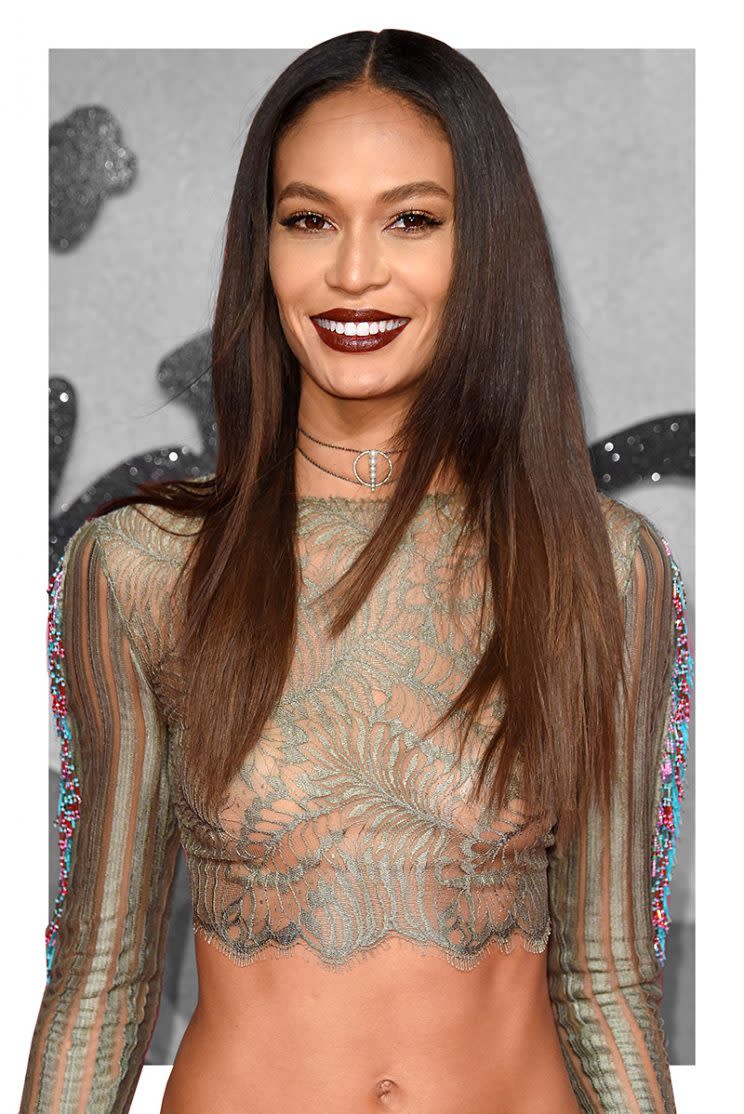Why It’s Ridiculous That Joan Smalls Has Trouble Booking Hair Campaigns

Joan Smalls has graced the cover of several fashion magazines, walked the runway for some of the industry’s most celebrated design houses, collaborated with brands on beauty and fashion projects, and is among the elite group of models included in several Victoria’s Secret Fashion Shows. She’s basically one of the most in-demand faces in the industry — but not, it seems, the most wanted head of hair.
“I’ve always had a struggle trying to get a hair campaign. It’s mind-boggling,” Smalls revealed on Dec. 3 in Chipping Norton, England, speaking on a panel about diversity and inclusivity with Hari Nef and Ivan Bart, president of IMG Models, for the Business of Fashion‘s Voices event, moderated by the publication’s own Tim Blanks. “I’ve been an option, but they dropped me last minute, and the excuse was ‘We were afraid to try something new,’ and by ‘new,’ they mean, ‘We never shot a black girl,'” said Smalls, who typically wears her hair straight.
The model spoke candidly about the discrimination she’s faced as a biracial Puerto Rican model in the industry.
“I come from an interracial family, and my household has every different shade. My world, I’ve always seen it as inclusive,” she explained. “Coming to New York and making a career out of modeling, they reminded me what we see you as, not who I identified with. That was a personal struggle, when people try to classify you as something that you don’t classify yourself as. I am black, I am Afro-Caribbean, I am Latina.”
Smalls said she was proud of all the aspects of her heritage, adding, “That is the world I see, and I feel like brands need to be open-minded and mindful when they choose their cast. Because they do hold a social responsibility to the world to represent their consumers.”
But in spite of her tremendous success in the industry, it seems, she still misses out on opportunities because of her ethnicity, and the fashion industry’s reluctance to move towards inclusivity — despite the fact that it would make economic sense.
Besides the obvious issues with discrimination, Joan’s difficulty in snagging hair campaigns is even more remarkable considering the vast buying power of black women, especially in the United States, and particularly in the beauty market. In 2013, Nielsen reported that African-Americans had a spending power of $1 trillion, which is expected to rise to $1.3 trillion in 2017. In 2009, a study found that African-American women spent $7.5 billion on beauty products. A 2014 study found that multicultural beauty products outpaced the market as a whole by 3.7 percent. Since then, a few mainstream brands have been trying to build up their offerings in order to get in on this moneymaking opportunity.
Last year, Mintel found that the sales of styling products had shot up 26.8 percent between 2013 and 2015, hitting $946 million, 35% of of which were sales of specialized products for African-American customers. Last year alone, hair care for the African-American market is estimated to have totaled over $2.7 billion in sales. And that’s a lot of money.
Mintel also found that African-Americans do a lot of experimentation with their hair, which means trying out several different products. While 20 percent of African-American consumers “buy a variety of products for the different hairstyles they wear,” the report notes, a similar amount of consumers report having trouble finding products that “fit their diverse range of hairstyles.” It adds that 19 percent of African-Americans “have bought multiple haircare products because they can’t find the right product that works for them.”
This is an opportunity for brands not only to develop products that suit the needs of the diverse textures black hair comes in, but also to use models of color — like Joan Smalls — to market to them. And given the fact that African-American women have been embracing the natural textures of their hair, we could even say that choosing to cast models with natural hair, like Maria Borges, Ebonee Davis, or Herieth Paul, is a great way to tap into that buying power. While, again, this means that a lot of brands may have to consider how and which products they are formulating, shampoos and conditioners are still items everyone uses. Why not delve into that market?
The issue is further complicated by the fact that African-Americans tend to buy black-owned when it comes to their hair. According to the Huffington Post, “Big business lacks the credibility of smaller brands who often are users of their own products and have built strong relationships with their consumers by sharing their own hair stories.”
It’s up to these big brands to gain credibility — and dollars — from black consumers. But in order to do that, they need to first engage, and part of that includes featuring black women in hair campaigns, regardless of their hair texture.
Let’s keep in touch! Follow Yahoo Beauty on Facebook, Twitter, Instagram, and Pinterest.
